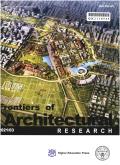Optimal design strategy of traditional courtyard based on performance and data-driven method—A case study of Yanshen ancient town, China
IF 3.6
1区 艺术学
0 ARCHITECTURE
引用次数: 0
Abstract
To address the insufficient integration of performance evaluation and contextual analysis in traditional architectural design, this paper proposes a design workflow that combines data-driven and performance-driven approaches, establishing a comprehensive operational pathway from typology selection and design generation to performance assessment. Using Yanshen Ancient Town, a cold region, as the study area, the research evaluates 18 traditional courtyard types and 8 brick kiln courtyard types. Benchmark models are selected based on the combined performance of PET (Physiological Equivalent Temperature) and MRT (Mean Radiant Temperature) indices. Subsequently, multiple performance indicators, including indoor and outdoor thermal comfort, indoor illuminance, and building energy consumption, are integrated into the analysis. Using a genetic algorithm, Pareto optimal solutions that meet performance requirements are iteratively optimized and filtered. Based on the learning rates and various evaluation indicators, XGBoost is ultimately selected to classify and predict the overall building performance. Results indicate that the model achieves an average prediction accuracy of 83.6%. Additionally, SHAP analysis of the independent variables in the algorithm reveals distinct influencing trends under different performance labels. The workflow demonstrates the feasibility of incorporating performance prediction in the early design stage of village courtyards, significantly enhancing the efficiency of feedback and follow-up between design decision-making and performance evaluation.
基于性能与数据驱动的传统院落优化设计策略——以盐深古镇为例
针对传统建筑设计中性能评估与情境分析结合不足的问题,本文提出了数据驱动与性能驱动相结合的设计工作流程,建立了从类型选择、设计生成到性能评估的综合操作路径。以寒区燕深古镇为研究区,对18种传统院落类型和8种砖窑院落类型进行了评价。基于PET (Physiological Equivalent Temperature,生理等效温度)和MRT (Mean Radiant Temperature,平均辐射温度)指标的综合性能选择基准模型。随后,将室内外热舒适、室内照度、建筑能耗等多个性能指标纳入分析。利用遗传算法对满足性能要求的Pareto最优解进行迭代优化和过滤。基于学习率和各种评价指标,最终选择XGBoost对建筑整体性能进行分类和预测。结果表明,该模型的平均预测精度为83.6%。此外,通过对算法中自变量的SHAP分析,揭示了不同业绩标签下的影响趋势。该工作流程验证了将性能预测纳入村寨庭院设计早期阶段的可行性,显著提高了设计决策与性能评估之间的反馈与跟踪效率。
本文章由计算机程序翻译,如有差异,请以英文原文为准。
求助全文
约1分钟内获得全文
求助全文
来源期刊

Frontiers of Architectural Research
ARCHITECTURE-
CiteScore
6.20
自引率
2.90%
发文量
430
审稿时长
30 weeks
期刊介绍:
Frontiers of Architectural Research is an international journal that publishes original research papers, review articles, and case studies to promote rapid communication and exchange among scholars, architects, and engineers. This journal introduces and reviews significant and pioneering achievements in the field of architecture research. Subject areas include the primary branches of architecture, such as architectural design and theory, architectural science and technology, urban planning, landscaping architecture, existing building renovation, and architectural heritage conservation. The journal encourages studies based on a rigorous scientific approach and state-of-the-art technology. All published papers reflect original research works and basic theories, models, computing, and design in architecture. High-quality papers addressing the social aspects of architecture are also welcome. This journal is strictly peer-reviewed and accepts only original manuscripts submitted in English.
 求助内容:
求助内容: 应助结果提醒方式:
应助结果提醒方式:


